If you buy through our links, we may earn an affiliate commission. This supports our mission to get more people active and outside.Learn about Outside Online's affiliate link policy
The Best Triathlon Saddles, Updated for 2025
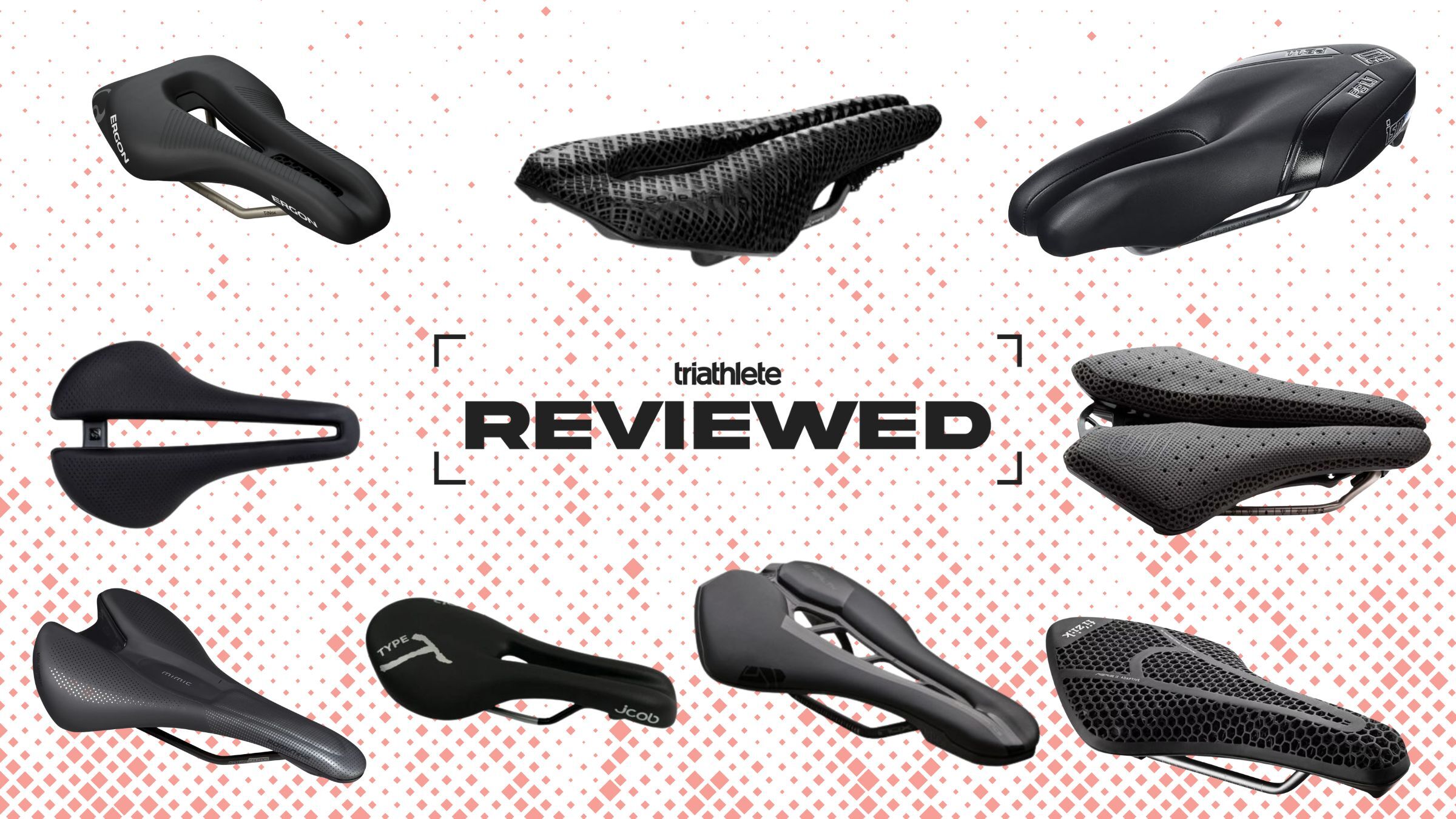
Looking to upgrade your saddle in 2025? We took a variety of triathlon bike seats out for a spin - these are our top picks. (Photo: Triathlete)
The Best Triathlon Saddles
A good triathlon saddle is a make-or-break piece of tri gear. You can always get by with a sub-par set of wheels, an old pair of running shoes, or a misfit swim cap. But a bad saddle can completely ruin your day, leading to saddle sores, numbness, injury, or a host of other painful problems.
Being comfortable in the saddle is one of the most underrated aspects of a triathlon. You can go on and on about wind tunnel testing, the fastest wetsuit on the market, or a running shoe that makes you 1% faster. But if you can’t hold that wind tunnel-tested aero bike position or generate effective power for the 4+ hours of the bike leg in your race, nothing else matters. So, how do you find the best triathlon saddle?
For this article, we sought out nine of the best triathlon saddles of 2025, including some that you may not have heard of. These saddles are designed for every triathlete, from beginner to professional, and are specifically molded for long hours in the aero position.
As we dive into our list, remember that saddle comfort and riding position are very individual. Every triathlete is different – varying sit bone widths, leg lengths, torso positions, saddle heights, hip angles, neck tilts, etc. – so it’s impossible to recommend a one-saddle-that-fits-all.
What makes a good triathlon saddle?
When searching for the best triathlon saddle, there are a few key aspects to look at. We’ll explain the shape of each triathlon saddle and why one shape might suit a certain type of rider over another. The width of the saddle and the width of its nose can also make a massive difference in overall comfort. We’ll also analyze the cutout style of each saddle, how deeply it runs through the saddle, and what kind of rider it might suit. Lastly, we’ll discuss the density and texture of each saddle and explain why beginner-level riders might prefer a softer and smoother saddle over a hard one.
This easy-to-use guide ranks each saddle based on various criteria, such as density, cutout, width, and more. Each criterion is explained in the table below, and you can read on to learn which is the best saddle for you.
| Criteria | Description |
| Overall Rating | While this rating doesn’t necessarily add up to a total average of other ratings, we look at a combination of shape, feel, and balance. Of course every body is different, but a higher rating here means it has the features and balance that go into naming a product one of the best triathlon saddles. |
| Density | This rating indicates the firmness of the saddle, with 1/5 being a very, very soft saddle, and 5/5 being incredibly firm, almost hard. |
| Width At Nose | This measurement indicates the width (in mm) of the saddle at the nose. If you have issues with chafing in your thighs, you may want to try a saddle with a narrower value here. If you ride the front of the saddle often and require support (and have no issues with chafing), you may want to try something wider. |
| Width At Sit Point | This measurement – gathered 100mm from the nose for tri and 125mm from the nose for road – approximates where the majority of riders actually sit. While the optimal value for this varies from person to person, this measurement will help you dial in your fit off of an existing saddle you own. |
| Width At Widest Point | This measurement tells you how many millimeters wide the saddle is at its widest. This value can also help once you have a baseline from an existing saddle. A wider saddle will typically give more support, but it’s important that it’s not so wide that it goes outside the optimal seating position for your body’s shape and/or creates chafing. |
| “Sweet Spot” Wiggle Room | On a scale of 1–5, with 1/5 indicating very few places to sit and 5/5 indicating many. If you like to move around on your saddle as you ride, look for a higher value here. |
| Cutout | This value tells you how much cutout is effectively used on the saddle. 1/5 means very minimal cutout and 5/5 indicates a very effective/maximal cutout. |
| Texture | This value helps provide guidance on how rough or smooth the saddle is. A value of 1/5 indicates a very smooth saddle – potentially better for someone who has chafing issues – and a value of 5/5 shows an almost sticky saddle – better for someone who has issues sliding around in a wet race kit or maybe uses an angled seat position as a part of their fit. |
Editor’s note: While the gear below was loaned out by the brands represented, all choices were selected independently by the tester without any promotional consideration or brand input. Also, unlike other “best triathlon bike review” websites, our testers physically evaluate the products themselves – no glancing at spec sheets and rewording marketing terms! Read how Triathlete tests gear for more.
RELATED: Ask A Gear Guru: Do I Need A New Saddle?
Best triathlon saddles of 2025
BiSaddle Hurricane Pro 3D

| Best Triathlon Saddles Category | Rating |
| Overall Rating | ★★★★★ |
| Density | ★★★★ |
| Width at Nose | 40mm-75mm |
| Width at Sit Point | 80mm-95mm |
| Width at Widest Point | 132mm-185mm |
| "Sweet Spot" Wiggle Room | ★★★★★ |
| Cutout | ★★★★★ |
| Texture | ★★★★ |
Three rides into testing the BiSaddle Hurricane Pro 3D, I started to develop a nasty saddle sore under my right sit bone. With normal saddles, I’d have few options, but with this micro-adjustable seat, I eliminated the offending pressure point by ever-so-slightly rotating the rear right half of the saddle inward.
Each side of the long-course tailored, nearly noseless BiSaddle adjusts independently via two bolts that allow you to widen or narrow the front and/or the back. Dealing with hip misalignment or uneven leg length? Persistent numbness or saddle sores in the undercarriage? With an Allen wrench and a few minutes of tinkering, you can dial in an asymmetrical fit, widen the central channel, or address angles that cause chafing.
Think twice if you ride more upright, because the blunt nose may make you feel like you’re falling off the front. (BiSaddle does make versions with longer noses and lower prices; check out this recent review.) And heads up if you’re allergic to Allen wrenches. While I found BiSaddle’s step-by-step instructions super easy to follow, you won’t get your money’s worth without 30 minutes of fine-tuning.
The Hurricane Pro 3D comes in three models: chromoly round rails ($399, 342g), titanium round rails ($449, 321g), and carbon fiber oval rails ($499, 282g).
– Jon Dorn
Ergon SR Tri Women Mid

| Best Triathlon Saddles Category | Rating |
| Overall Rating | ★★★★★ |
| Density | ★★★ |
| Width at Nose | 49mm |
| Width at Sitpoint | 58mm |
| Width at Widest Point | 130mm |
| "Sweet Spot" Wiggle Room | ★★★★ |
| Cutout | ★★★★ |
| Texture | ★★★ |
Ergon has released its first saddles for triathlon in men- and women-specific designs. I found the Ergon SR Tri Women’s version to be comfortable without being overly plush and comfortable for long-distance riding.
The Ergon triathlon saddle comes in two versions for ladies (and two for men): one designed for those who ride more on the front of the saddle and one for those who prefer to ride more in the middle part of the saddle. Personally, the mid-position seat gave me more wiggle room to ride in various positions and greater installation flexibility.
As a suburbanite, I liked how I could sit up, come in and out of the saddle for intersections, and still pedal comfortably even when head’s-up riding on busy streets on my way out to quieter country roads.
The women-specific saddle offers a 3D-printed relief channel insert at the nose of the saddle for added comfort.
– Rebekah Brately
ISM PS 1.1
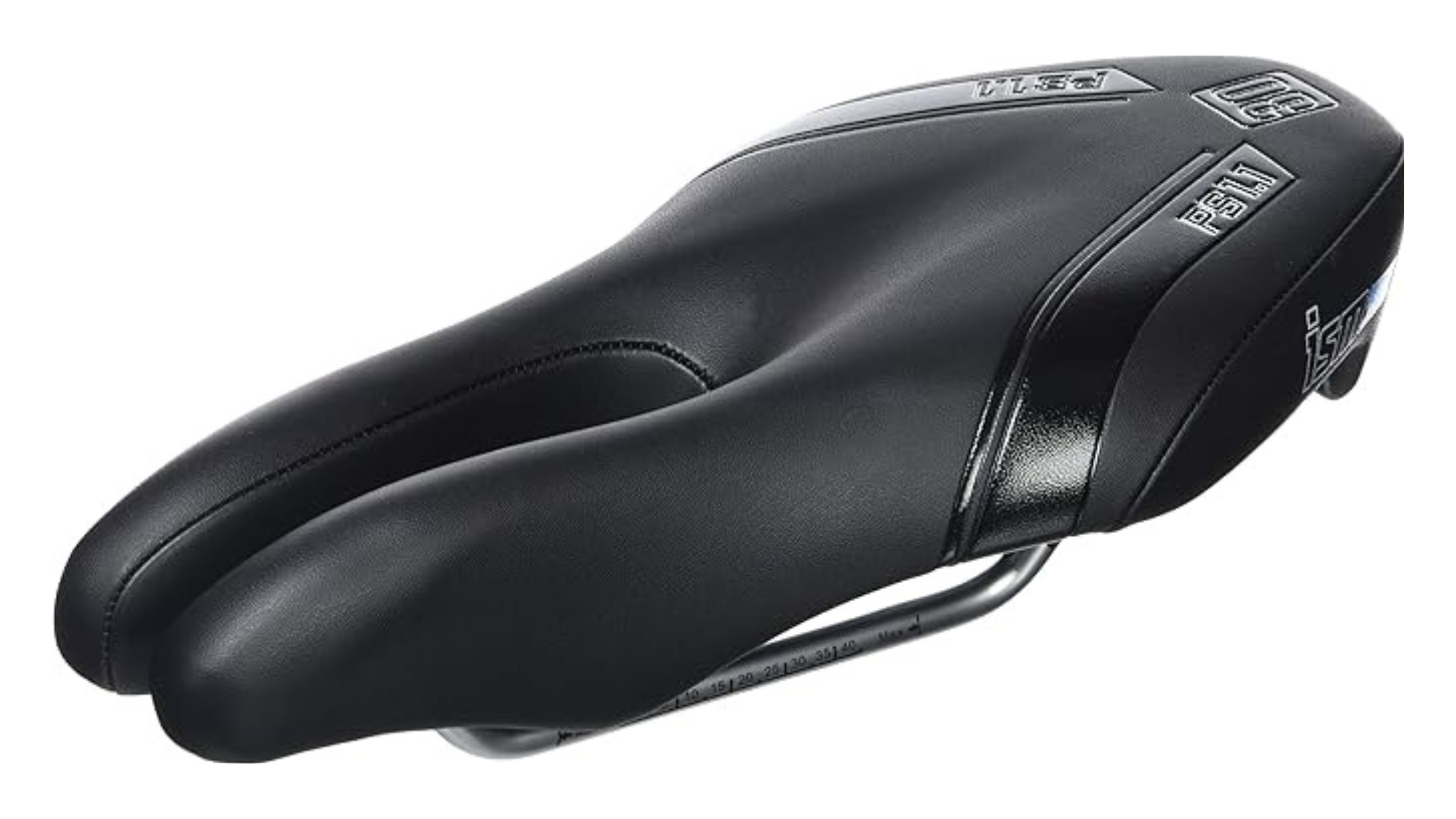
| Best Triathlon Saddles Category | Rating |
| Overall Rating | ★★★★ |
| Density | ★★★★ |
| Width at Nose | 58mm |
| Width at Sit Point | 65mm |
| Width at Widest Point | 130mm |
| "Sweet Spot" Wiggle Room | ★★ |
| Cutout | ★★★ |
| Texture | ★ |
The ISM PS 1.1 is a good triathlon bike seat for long distances to prevent thigh rubbing. However, the seat is pretty firm, which I found takes some getting used to – though some may appreciate it. The ISM PS 1.1 provides support in the right places to help transition to running comfortably and prevent post-ride soreness.
This is a saddle designed for those who find a comfortable position and stay put, something I’m not great at, which is why I gave it low scores for wiggle room. I found it took some time to settle back in and find the sweet spot if I came out of the saddle for any reason.
ISM offers clear instructions to help get the fit right when transitioning to the PS 1.1, which is welcomed help as you test and re-test riding positions to get everything just how you want it, regardless of your bike mechanic skills.
– R.B.
Transiro Aeris Long Distance R3 Adaptive
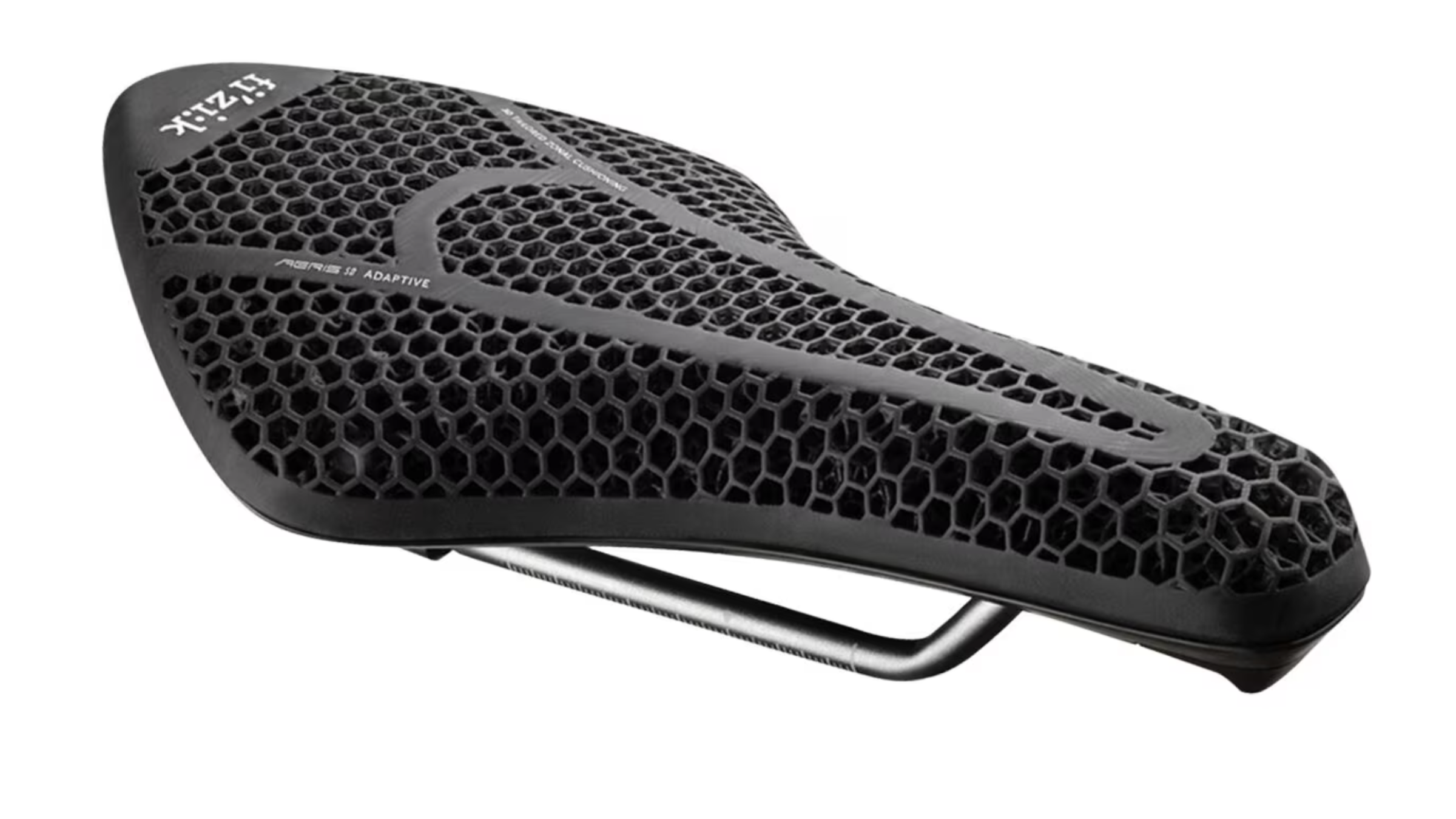
| Best Triathlon Saddles Category | Rating |
| Overall Rating | ★★★★ |
| Density | ★★★★ |
| Width at Nose | 55mm |
| Width at Sit Point | 75mm |
| Width at Widest Point | 135mm |
| "Sweet Spot" Wiggle Room | ★★ |
| Cutout | ★★★★ |
| Texture | ★★★ |
The Transiro Aeris Long Distance R3 Adaptive strikes a very satisfying balance between hard and soft. It’s also a great example of the benefits of 3D printing with variable padding zones, placing firmer cushion down the centerline of the pads and softer cushion around the edges.
With its abbreviated nose and generous, spongy central channel, the Aeris LD R3 is ideally suited to riders who can hammer indefinitely in a deep time-trial position. I felt zero pressure points around my you-know-what as long as I stayed long, low, and forward.
But there’s a caveat. When I came out of aero to sit up or shift back, my chicken-skinny legs rubbed against the tall and textured nose. The nose is taller than any saddle I’ve ridden, which meant my thighs had to angle just a bit wider to clear it. When they didn’t, my shorts caught on the honeycombed surface. That’s why I gave the Aeris LD R3 a lower “wiggle room” score: For me, there was just one sweet spot position, albeit a very sweet one.
The honeycombed texture – another 3D-enabled innovation – is extremely grippy and the abundance of tiny channels creates airflow that makes the saddle noticeably cooler. But if I’m nitpicking, I’d vote for fewer or smaller holes in the honeycomb, for the reasons above but also because the texture started to irritate my cheeks on wet Ironman-distance rides. If there is rubbing, consider the non-3D version of the Transiro Aeris.
– J.D.
Specialized Romin EVO Comp with MIMIC
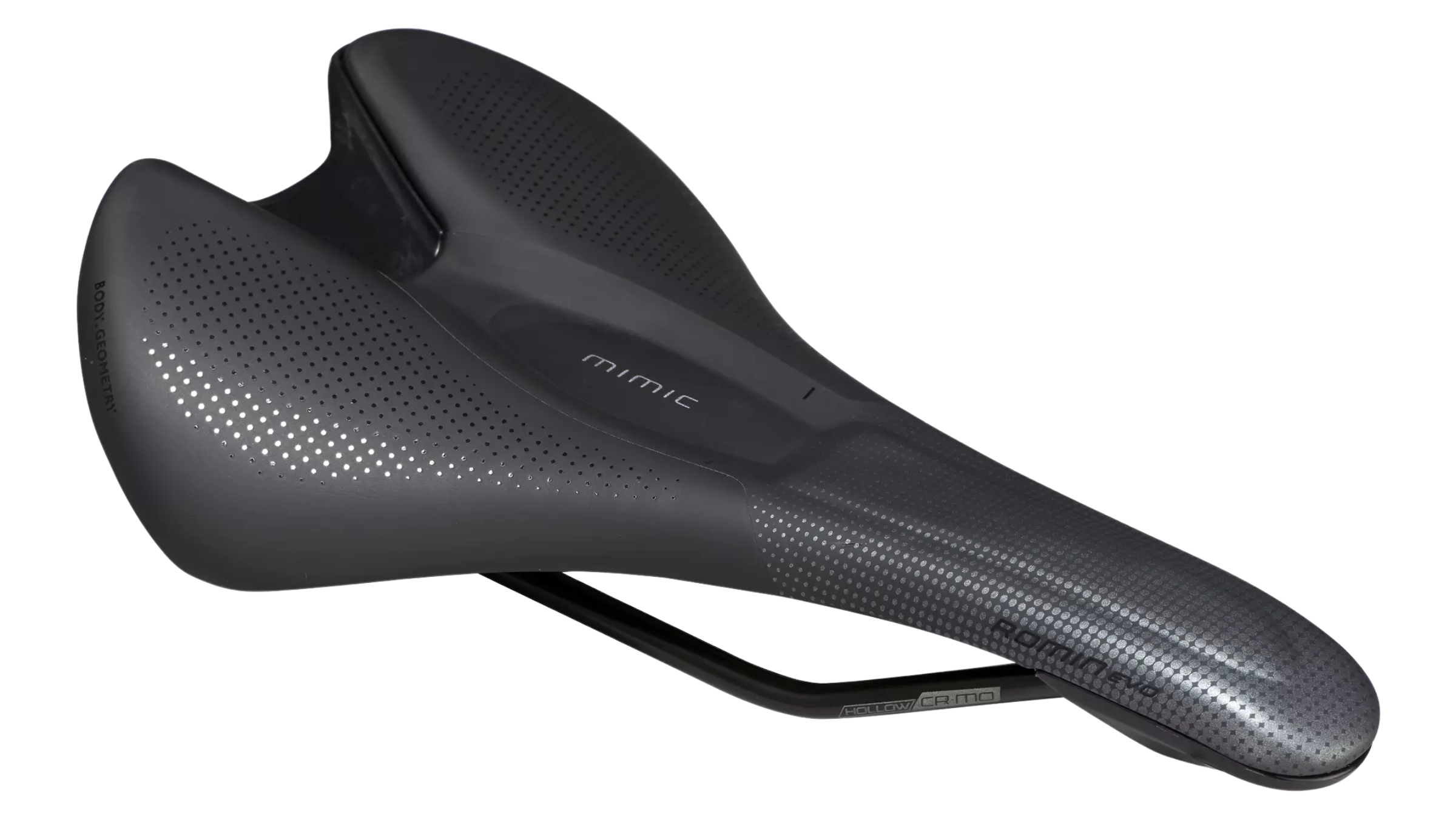
| Best Triathlon Saddles Category | Rating |
| Overall Rating | ★★★ |
| Density | ★★★★ |
| Width at Nose | 30mm |
| Width at Sitpoint | 55mm |
| Width at Widest Point | 143mm, 155mm, or 168mm |
| "Sweet Spot" WIggle Room | ★★★★ |
| Cutout | ★ |
| Texture | ★★★ |
If you’re not ready to transition to a noseless saddle, want a more budget-friendly option, or prefer to have more riding position options, the Specialized Romin EVO Comp road bike saddle might be right for you.
As many triathletes can attest, you can still easily achieve an aero position (or ride in the drops) on a road bike. Softer foam at the front of the Romin offers relief for soft tissue while firmer foam in the rear supports your sit bones. It comes in three size options specifically designed for female riders to help you find the right support for your anatomy.
The Specialized Romin EVO Comp is firm for performance in aggressive riding positions while offering a large enough seat surface for wiggle room. However, I found the cutout insufficient for ultimate comfort in the aero or the drops for long periods. I had no qualms with the comfort of riding in a more upright position on the seat.
– R.B.
Selle Italia 3D-printed Watt Kit Carbino Superflow
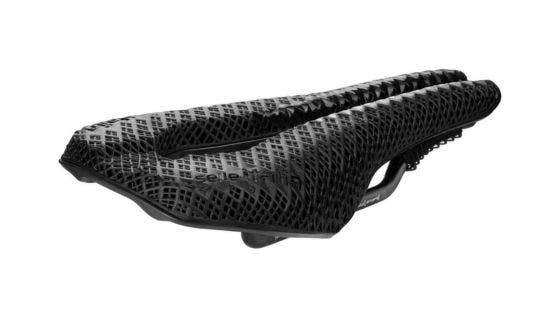
| Best Triathlon Saddles Category | Rating |
| Overall Rating | ★★★★ |
| Density | ★★★ |
| Width at Nose | 45mm |
| Width at Sit Point | 70mm |
| Width at Widest Point | 133mm |
| "Sweet Spot" Wiggle Room | ★★★★ |
| Cutout | ★★★★★ |
| Texture | ★★★★★ |
The most expensive saddle on our list is 3D-printed – who could’ve guessed that? But the Selle Italia 3D-printed Watt Kit Carbino Superflow delivers the quality that 3D printing promises. This was certainly one of my favorite saddles, and the only reason this saddle isn’t a five out of five is the price.
Made with an anti-slip coating, the Watt Kit Carbino Superflow looks as interesting as it feels. The mesh material is squishy and supple, and it’s anti-slip, as claimed. This saddle also features the biggest cutout of any saddle on this list, cut from the nose through about 90% of the saddle’s length. In terms of overall comfort, the Watt Kit Carbino Superflow was certainly the most comfortable saddle I tested.
If you press your thumbs into the saddle, you can actually feel which areas are firmer and which are softer. Of course, non-3D-printed saddles can do this, but it feels so much better and specifically intentional using 3D-printed materials. Thanks to its long and fairly narrow shape, the Watt Kit Carbino Superflow has one of the biggest “Sweet Spot” Wiggle Rooms that we tested. That means you could move forward or backward on the saddle and still find somewhere comfortable to sit.
Read our extended review of the Watt Kit Carbino Superflow.
– Zach Nehr
Bontrager Aeolus Pro Saddle
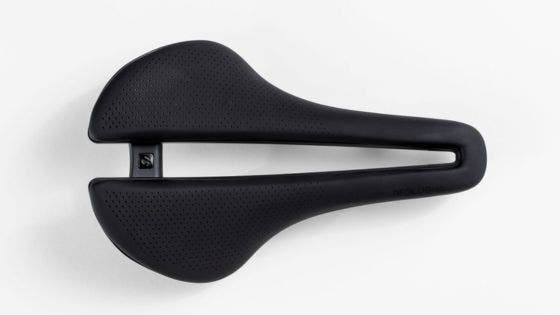
| Best Triathlon Saddles Category | Rating |
| Overall Rating | ★★★★ |
| Density | ★★★★ |
| Width at Nose | 45mm |
| Width at Sit Point | 75mm |
| Width at Widest Point | 145mm |
| "Sweet Spot" Wiggle Room | ★★★★ |
| Cutout | ★★★★★ |
| Texture | ★★★ |
The first thing that stands out about the Bontrager Aeolus Pro is its shape and cutout. Instead of a cutout through the nose of the saddle, the Bontrager Aeolus Pro has a complete cutout through the rear. This helps relieve pressure in a variety of seated positions, especially at the sit point and rear of the saddle.
As with all saddles, comfort in the aero position is a personal preference depending on where you sit on the saddle and how aggressive your position is. Since I sit closer to the front of the saddle, I prefer a saddle with a cutout through the nose, which the Bontrager Aeolus Pro does not have. However, the saddle was still comfortable overall, just not a 10 out of 10.
I found myself slipping on the saddle a bit in the aero position, but that was only during hard efforts when I was pulling myself toward the saddle’s nose. The Bontrager Aeolus Pro doesn’t have the grippiest surface, but some riders prefer it that way because it gives them more freedom to move around in the saddle.
Speaking of wiggle room, the Bontrager Aeolus Pro had one of the best of any saddle, thanks to its shape and cutout. It’s quite a dense saddle as well, which I love, but other riders don’t. Beginner-level riders might prefer more padding, while experienced riders who spend hours in the saddle prefer a certain firmness.
Overall, the Bontrager Aeolus Pro is a well-rounded saddle for all triathletes. It is also designed to integrate with a variety of Bontrager and Trek products, including their saddle bag, rear light, and fender.
– Z.N.
Speed And Comfort Type T
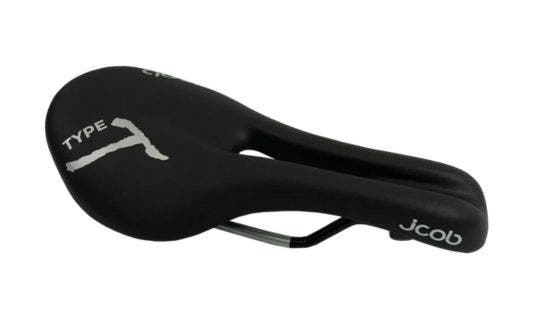
| Best Triathlon Saddles Category | Rating |
| Overall Rating | ★★★ |
| Density | ★★★ |
| Width at Nose | 40mm |
| Width at Sit Point | 57mm |
| Width at Widest Point | 155mm |
| "Sweet Spot" Wiggle Room | ★★★ |
| Cutout | ★★ |
| Texture | ★★★★ |
This saddle was designed with female riders in mind, specifically those who prefer to sit more upright. As a result, it’s likely not the best choice for the competitive triathlete. It has a very narrow nose (and it is narrower at the rear of the nose than it is at the front), which took us some time to get used to. Initially, this led to quite a lot of fidgeting in the saddle. The manufacturer said this design is intended to give “those upper thighs a lot of extra room,” but in reality it really just led to a lot of extra wiggle time. This saddle also feels very wide at the rear (much wider than its measurements would suggest), so it might be a better option for those who like to ride further back in their saddle and/or push back in the saddle.
– Emma-Kate Lidbury
Shimano Pro Stealth Performance Saddle
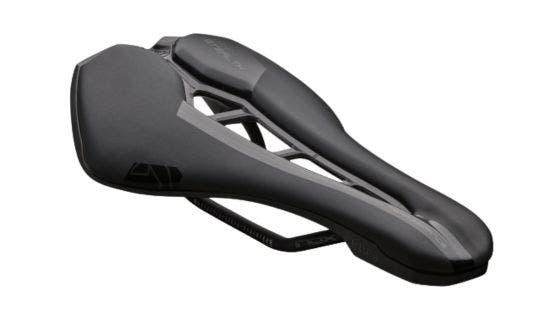
| Best Triathlon Saddles Category | Rating |
| Overall Rating | ★★★★ |
| Density | ★★★★ |
| Width at Nose | 50mm |
| Width at Sit Point | 63.5mm |
| Width at Widest Point | 152mm |
| "Sweet Spot" Wiggle Room | ★★★★ |
| Cutout | ★★★★★ |
| Texture | ★★★ |
This saddle is unabashedly performance-oriented, with firm support and maximal cutouts. Our tester really enjoyed the slightly-downturned wings that help increase comfort and “wiggle room” in what is otherwise a lightweight, racer-type saddle.
Riders who like sitting further forward on their saddles will likely get on well with the Stealth Performance – its short nose and slightly wider measurements at the sit point provide plenty of options (comfortable ones) for those who like to ride in the tri bars or use this saddle on a road or gravel bike. If you’re someone who prefers more support/comfort than this might not be your ticket to ride: It is definitely less textured than most and features some fairly aggressive cutouts.
– E.K.L